Geladas and the Simien Mountains
- hm
- May 26
- 6 min read
From Lalibela, I boarded a short flight to Gondar, a city often called the Camelot of Africa. Nestled in Ethiopia’s northern highlands, Gondar is famed for its 17th-century castles, ornate churches, and imperial baths — remnants of a golden age when emperors ruled from stone fortresses.
I had setup a tour to hike the Simien mountains for three days and was picked up by the guide at the airport.
During the Italian occupation of Ethiopia (1936–1941), Gondar was an urban center, and sports an Italian-style Piazza, also known as Atse Tewodros Square. This area became the heart of the city’s colonial architecture — a blend of modernist and rationalist styles, the areas I saw as we drove towards the Simien Mountains about 2 hour and 110km drive away.
The road has sweeping views of the highlands — valleys, cliffs, and distant peaks unfold like a panorama. The road passes through steep farmlands and hamlets, and their traditional highland agriculture passes by as we go to the main town Debark. From there, the road becomes rougher and steeper.
Finally, we approached the Simien Mountain national park, and our overnight stay was at the Sankaber Camp which had a large room with many beds. The guide made coffee and popcorn which felt pretty good to enjoy at 10,000 feet elevation.
While the chef was preparing dinner, we went for a couple hour hike and saw the grand mountains and the rift valleys.
Dinner was served and consisted of soup, vegetables and sphagetti. We had to get up early for the whole day hike the following morning.
Dinner was simple yet satisfying — a warm bowl of soup, gently steamed vegetables, and a modest plate of spaghetti. The conversation was quiet, and a hiker from Czechia had joined us.
Tomorrow would bring a full-day hike into the heart of the Simien Mountains, and we knew the stillness of this evening was a gift — a pause before the rhythm of boots on trail resumed.
The moon lingered high above like a gentle sentinel, casting its pale glow across the sleeping ridges of the Simien Mountains. I had woken early — not from urgency, but anticipation.
As dawn crept in, golden light spilled softly over the landscape, teasing details out of shadow: rugged cliffs, whispering grass, and silhouettes of trees. A new day in the Simien Mountains begun.
The trail wound through towering ridgelines and vast, craggy valleys — the vista that made me feel both small and alive.
Early on, we passed a weathered board etched with the image of Menelik’s bushbucks, their spiraled horns like tribal markings of the highlands. The idea of glimpsing one in the wild had us scanning every patch of brush.
Overhead, birds of prey circled and around us, ragged peaks rose like ancient fortresses, shaped by wind, water, and time. The rock walls bore the story of millions of years, layer upon layer of sediment revealing the restless history of the earth. Every step felt epic — this was turning out to be memorable hike.
For nearly two hours, we trekked along cliff-hugging trails, passing wind-swept plateaus. Then, through a break in the landscape, it came into view — Jinbar Waterfall, plunging in a silver sheet into the yawning Geech Abyss below.
The sound reached us before the mist, a soft roar echoing off ancient rock. At 530 meters, it’s one of Africa’s tallest waterfall, and watching its relentless tumble felt almost meditative.
While I eagerly ventured to the very edge of the cliff, angling for the perfect shot of mist and mountain majesty, my Czech co-hiker remained a few paces behind — quietly rooted to safer ground. Heights weren’t his thing, and he preferred the stillness of the backdrop, watching the falls tumble from afar. We each took in the view in our own way — one through a camera lens, the other through binoculars — both swept up in the magic of the Simien.
Flowers and waterfalls, raptors and buzzards, cliffs and valleys — each element was in its natural habitat weaving the mystery across time.
The alpine blooms, scattered like confetti on the trail and Jinbar’s misty cascade roared in the distance while vultures drifted overhead, carving circles into the sky with effortless grace.
Peaks jutted like ancient spires, valleys plunged into secrets, and the whole landscape held its breath — a wilderness that beckoned both awe and adventure.
For hours, I hiked with quiet hope — scanning cliffs, listening for rustles in the grass, imagining the golden manes and crimson chests of the elusive Gelada monkeys.
They were rumored to roam these highlands, and I longed to witness them in their wild habitat. But four hours passed, and the trail offered only silence. Then, just as my hope began to thin, I looked across a distant ridge — and there they were. Dozens of them, grazing and grooming, their presence as sudden and magical as a secret finally shared.
Geladas, often called bleeding-heart monkeys, are endemic to Ethiopia’s highlands and are the world’s only grass-grazing primates. With their flowing golden manes and bright red chest patches, they roam the Simien Mountains in large, complex social groups — a mesmerizing blend of wild beauty and intricate behavior.
The trail meandered through alternating narrows and wide, open stretches — the kind that offered both adventure and grandeur in equal measure. Jagged cliffs loomed like silent sentries, while rivulets of water tumbled gently between rocks, glinting in the morning light.
Grasshoppers leapt from unseen corners, their crimson bellies flashing as they took flight from camouflaged shelter. Every few bends brought encounters with local shepherd children, their flocks scattered across the hillsides.
For a handful of birr and a smile, they stood proudly for a photo, capturing a moment that blended humanity into the landscape’s wild beauty.
Far across the valley, my eyes locked onto a trio of Geladas silhouetted against the cliffs — golden manes haloed by the morning light. They were distant, barely discernible to the naked eye, but with my phone’s 15x zoom I captured a fleeting miracle.
The video shows them bounding in perfect unison, their manes rippling like banners of flame as they danced across the escarpment. I stole a moment from nature’s choreography, wild and exquisite.
The two-hour hike had left us tired until we reached a thundering waterfall spilling into a river that raced with icy determination. A cow was being herded across as the herder coaxed her.
Then it was our turn. The water was deep and fast, a living force that grabbed at our legs, and I hesitated — caught between fear and necessity. I can't swim, and the cold bit sharply, but my guide took my arm with practiced calm and led me through, one deliberate step at a time.
Above us, a group of Geladas perched on sunlit ledges, watching the spectacle below like amused spectators, their manes fluttering in the breeze.
Among lobelias and geladas, mountaintops and rough rock scrambles, we trudged onward — breath shallow, hearts thudding with altitude and awe. At nearly 12,000 feet, the air was thin, the terrain unforgiving, yet everything around us seemed painted in wild glory.
Fluffy clouds drifted lazily overhead, casting moving shadows over the golden grasslands, while serrated cliffs carved dramatic silhouettes against the sky. Each step felt earned — a rhythm of exertion and exhilaration, with the landscape unfolding like a masterpiece too vast to frame.
With coffee warming our hands and popcorn crunching softly between stories, the evening at camp felt like a well-earned exhale.
But curiosity tugged us onward. We set out once more, this time toward a nearby mountaintop — not just any peak, but the highest point in the region, where altitude met awe.
The trail narrowed and climbed, the air crisp and thin. As we reached the summit, the landscape spilled out beneath us in all directions, a tapestry of stone and cloud.
One peculiar rock stole the scene — weathered over centuries, it stood proudly with an almost perfect circular hole carved through its center, like nature’s own window to the world. It was a final flourish on a day steeped in altitude and wonder.
By 6am, the mountains were already whispering — a cool hush brushing through lobelias as we set off for a four-hour trek woven through forest and stream.
The path dipped and twisted, tracing the spine of the highlands as rivers meandered across it like silvery threads. A couple were bold enough to block our way, forcing us to wade through water that clutched at our ankles and surged with alpine chill.
Steep ravines opened up beside us, their walls embroidered with wildflowers in pinks, yellows, and violet — a riot of color blooming defiantly from the rock. Each step carried us deeper into the quiet majesty of the Simien.
Our two days hike concluded at 11 am and I climbed into the waiting vehicle — bound for Aksum, the ancient cradle of kings and legends. The road ahead would be long and unforgiving, a ten-hour journey through rugged mountains and the scarred landscapes of Tigray, where history and hardship intertwine and a civil war still in progress.

Just before we pulled away, I caught sight of a solitary Gelada perched on the cliffside, its golden mane catching the sunlight. It didn’t move, just watched — as if offering a silent farewell, a wild blessing for the road ahead.



















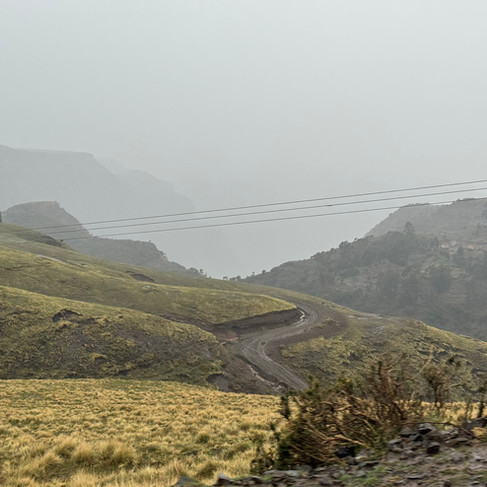























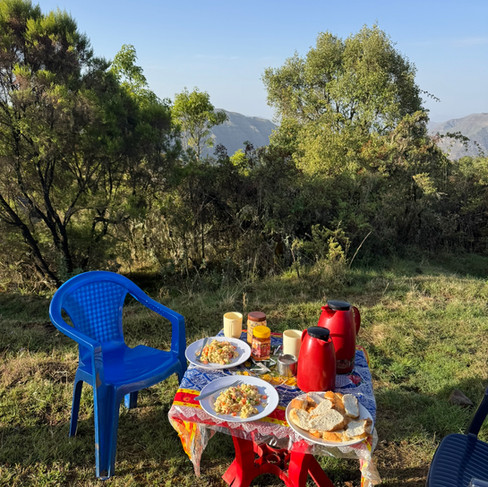





























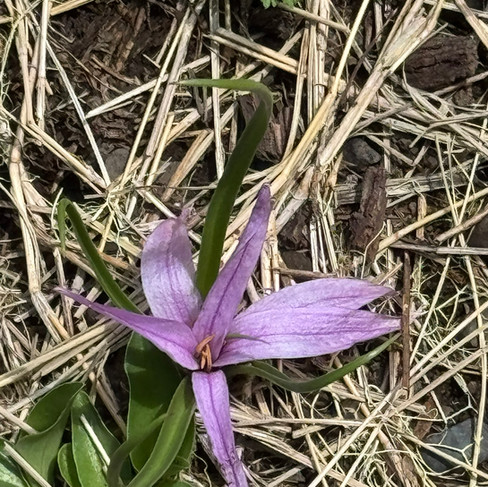





















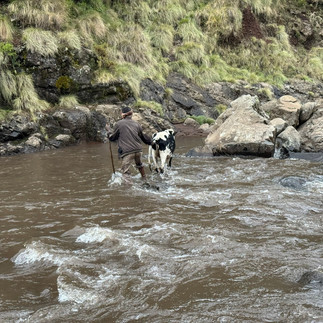































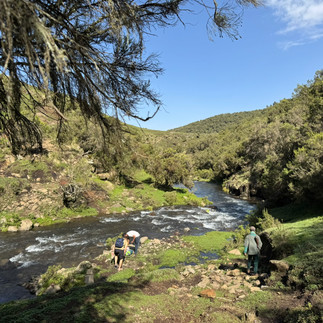













Comments